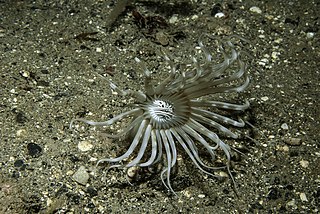 W
WArachnactidae is a family of tube-dwelling anemones in the order Ceriantharia. It is the only family in the monotypic order Penicillaria and comprises around 38 species. They differ from other ceriantharians in the makeup of their cnidome, the relative sizes of the oral discs and the shape and structure of the mesenteries. These tube anemones dwell in parchment-like tubes immersed in soft sediment, and have two whorls of tentacles, the outer ones being much longer than the inner ones.
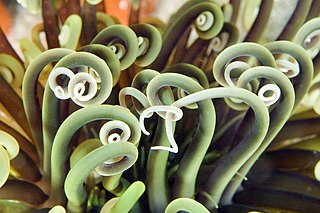 W
WCerianthidae is a family of tube-dwelling anemones in the order Spirularia of the subclass Ceriantharia.
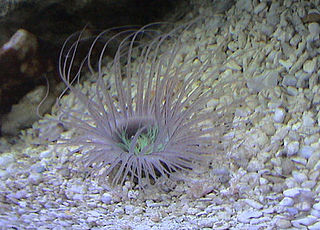 W
WTube-dwelling anemones or ceriantharians look very similar to sea anemones but belong to an entirely different subclass of anthozoans. They are solitary, living buried in soft sediments. Tube anemones live inside and can withdraw into tubes, which are composed of a fibrous material made from secreted mucus and threads of nematocyst-like organelles known as ptychocysts. Within the tubes of these ceriantharians, more than one polyp is present, which is an exceptional trait because species that create tube systems usually contain only one polyp per tube. Ceriantharians were formerly classified in the taxon Ceriantipatharia along with the black corals but have since been moved to their own subclass, Ceriantharia.
 W
WArachnanthus is a genus of tube-dwelling anemones in the family Arachnactidae. Members of the genus are found worldwide.
 W
WArachnanthus sarsi is a species of tube-dwelling anemone in the family Arachnactidae. This species is found in the North Atlantic in subtidal sand or muddy sand at depths of 15–130 m.
 W
WThe burrowing anemone is a species of tube-dwelling anemone in the family Cerianthidae.
 W
WCeriantheopsis is a genus of tube-dwelling anemones in the family Cerianthidae. Members of the genus are found only in the Atlantic Ocean. They are predators, scavengers and omnivores.
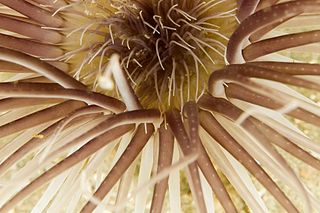 W
WCeriantheopsis americana is a species of tube-dwelling anemone in the family Cerianthidae. It is a burrowing species and lives in deep sand or muddy sand in a long slender tube that it creates.
 W
WCerianthus is a genus of tube-dwelling anemones in the family Cerianthidae. Members of the genus are found worldwide. They are predators, scavengers and omnivores.
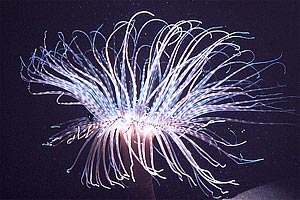 W
WCerianthus filiformis is a species of tube-dwelling sea anemone in the family Cerianthidae. It is found throughout the tropical waters of the western Indo-Pacific Ocean.
 W
WCerianthus membranaceus, the cylinder anemone or coloured tube anemone, is a species of large, tube-dwelling anemone in the family Cerianthidae. It is native to the Mediterranean Sea and adjoining parts of the northeastern Atlantic Ocean.
 W
WPachycerianthus is a genus of marine tube-dwelling anemones in the family Cerianthidae.
 W
WPachycerianthus fimbriatus is a cerianthid anemone that burrows in substrate and lives in a semi-rigid tube made of felted nematocysts. The anemone is often seen in bright orange to red.
 W
WPachycerianthus multiplicatus, commonly known as the firework anemone, is a species of tube anemone in the family Cerianthidae. This species is found in sheltered, subtidal mud at depths of 10 - 130m.
 W
WArachnactidae is a family of tube-dwelling anemones in the order Ceriantharia. It is the only family in the monotypic order Penicillaria and comprises around 38 species. They differ from other ceriantharians in the makeup of their cnidome, the relative sizes of the oral discs and the shape and structure of the mesenteries. These tube anemones dwell in parchment-like tubes immersed in soft sediment, and have two whorls of tentacles, the outer ones being much longer than the inner ones.
 W
WSpirularia is an order of marine Cnidarians, tube-dwelling anemones, in the subclass Ceriantharia. It is one of the two orders making up Ceriantharia and includes two families, Botrucnidiferidae and Cerianthidae, and around 99 species. The two orders differ in the makeup of their cnidome, the relative sizes of the oral discs and the shape and structure of the mesenteries.